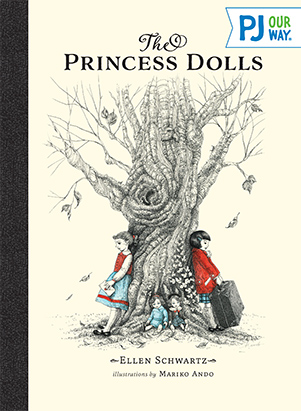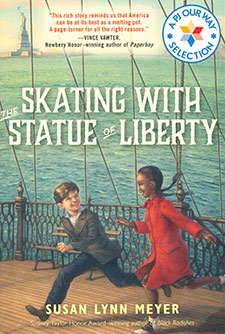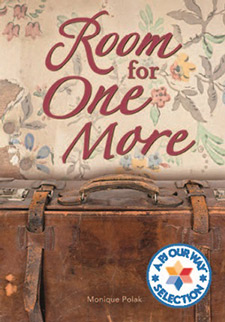The Princess Dolls
BFFs Esther and Michi long for matching dolls of English princesses Elizabeth and Margaret. But only one of them gets her birthday wish. Then Michi’s family must leave their home just because they are Japanese Canadians. How can Esther make things right again?
Average Rating
( hint: Login to leave a review! )
82 Reviews
Leave Review
What the Book Is About
Jewish Content & Values
Positive Role Models
Content Advisory
Talk It Over
More for You
What the Book Is About
Japan has bombed Pearl Harbor, but best friends Esther and Michiko are focused on getting beautiful dolls of British princesses Elizabeth and Margaret for their joint birthday. When Esther is given a doll but Michi isn’t, the girls fight and stop speaking to each other. Esther tries and fails to make amends, but before she can try again, Michi’s family, along with other Japanese Canadians, are sent to an internment camp in the center of the country. Esther is determined to do whatever it takes to heal their friendship.
Jewish Content & Values
- There’s a reference to Esther wearing her Rosh Hashanah dress to parties. Esther’s grandmother uses some Yiddish words.
- Esther’s father does tikkun olam (repairing the world) by writing in the newspaper about the injustice of interning Japanese Canadians.
Positive Role Models
- When Esther tries and fails to make up with Michi, she doesn’t give up until she finds a way to mend their friendship.
- Esther’s father risks his job to write about the injustices being done to Japanese Canadians.
Content Advisory
Anti-Japanese sentiment is growing after Pearl Harbor, and a racist picture of a Japanese soldier is taped to the door of Michiko’s family’s store. Japanese Canadians, including Michiko’s family, are sent to an internment camp. There is a reference to Jews being rounded up by Nazis and sent to work camps. Esther’s grandmother is worried about her sister, who is still in Germany, but the sister is able to reach safety in Switzerland. Grandma Sadie has a real fur coat, which may upset some readers.
Talk It Over
Esther and Michiko both really want the Princess Elizabeth and Princess Margaret dolls, but only Esther gets one, so the girls fight. Has a friend ever been jealous of something you had, or the other way around? How did you resolve things?
More for You
During World War II, the Canadian government interned approximately 22,000 Japanese Canadians and confiscated and sold their homes. They also interned almost 3,000 Jewish refugees from Austria and Germany. The refugees were held in camps alongside prisoners of war, many of whom were Nazis. Both the Japanese Canadians and the Jewish refugees were considered enemy aliens. Yet Japanese Canadians had fought for their country in World War I, and they served in World War II until they were banned from doing so after Pearl Harbor. Meanwhile, 40% of Jewish Canadian men served in the armed forces during the war, and Jewish philanthropist Samuel Bronfman donated a yacht to the Royal Canadian Navy reserves to be used for training.
What the Book Is About
What the Book Is About
Japan has bombed Pearl Harbor, but best friends Esther and Michiko are focused on getting beautiful dolls of British princesses Elizabeth and Margaret for their joint birthday. When Esther is given a doll but Michi isn’t, the girls fight and stop speaking to each other. Esther tries and fails to make amends, but before she can try again, Michi’s family, along with other Japanese Canadians, are sent to an internment camp in the center of the country. Esther is determined to do whatever it takes to heal their friendship.
Jewish Content & Values
Jewish Content & Values
- There’s a reference to Esther wearing her Rosh Hashanah dress to parties. Esther’s grandmother uses some Yiddish words.
- Esther’s father does tikkun olam (repairing the world) by writing in the newspaper about the injustice of interning Japanese Canadians.
Positive Role Models
Positive Role Models
- When Esther tries and fails to make up with Michi, she doesn’t give up until she finds a way to mend their friendship.
- Esther’s father risks his job to write about the injustices being done to Japanese Canadians.
Content Advisory
Content Advisory
Anti-Japanese sentiment is growing after Pearl Harbor, and a racist picture of a Japanese soldier is taped to the door of Michiko’s family’s store. Japanese Canadians, including Michiko’s family, are sent to an internment camp. There is a reference to Jews being rounded up by Nazis and sent to work camps. Esther’s grandmother is worried about her sister, who is still in Germany, but the sister is able to reach safety in Switzerland. Grandma Sadie has a real fur coat, which may upset some readers.
Talk It Over
Talk It Over
Esther and Michiko both really want the Princess Elizabeth and Princess Margaret dolls, but only Esther gets one, so the girls fight. Has a friend ever been jealous of something you had, or the other way around? How did you resolve things?
More for You
More for You
During World War II, the Canadian government interned approximately 22,000 Japanese Canadians and confiscated and sold their homes. They also interned almost 3,000 Jewish refugees from Austria and Germany. The refugees were held in camps alongside prisoners of war, many of whom were Nazis. Both the Japanese Canadians and the Jewish refugees were considered enemy aliens. Yet Japanese Canadians had fought for their country in World War I, and they served in World War II until they were banned from doing so after Pearl Harbor. Meanwhile, 40% of Jewish Canadian men served in the armed forces during the war, and Jewish philanthropist Samuel Bronfman donated a yacht to the Royal Canadian Navy reserves to be used for training.




